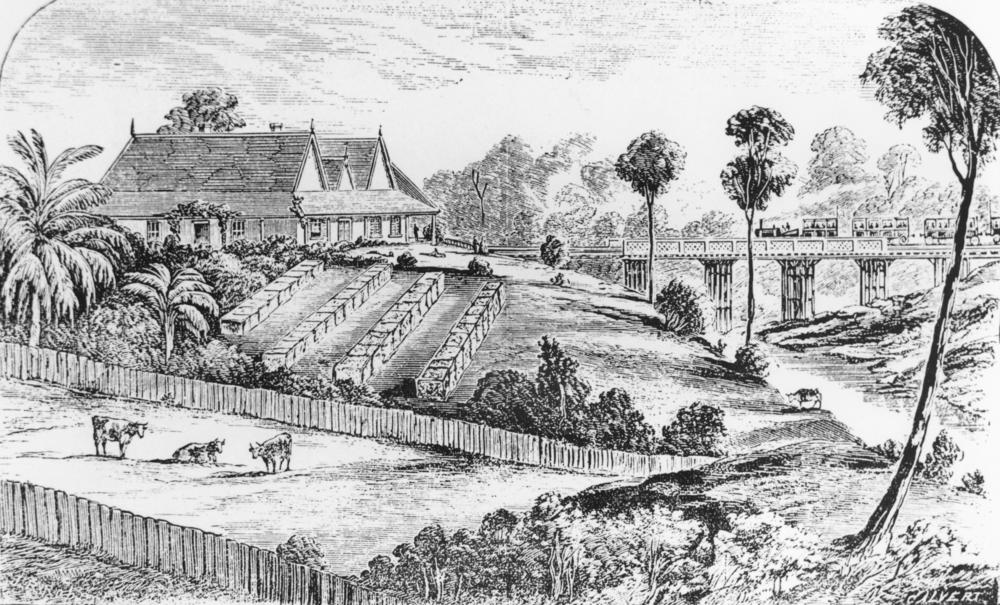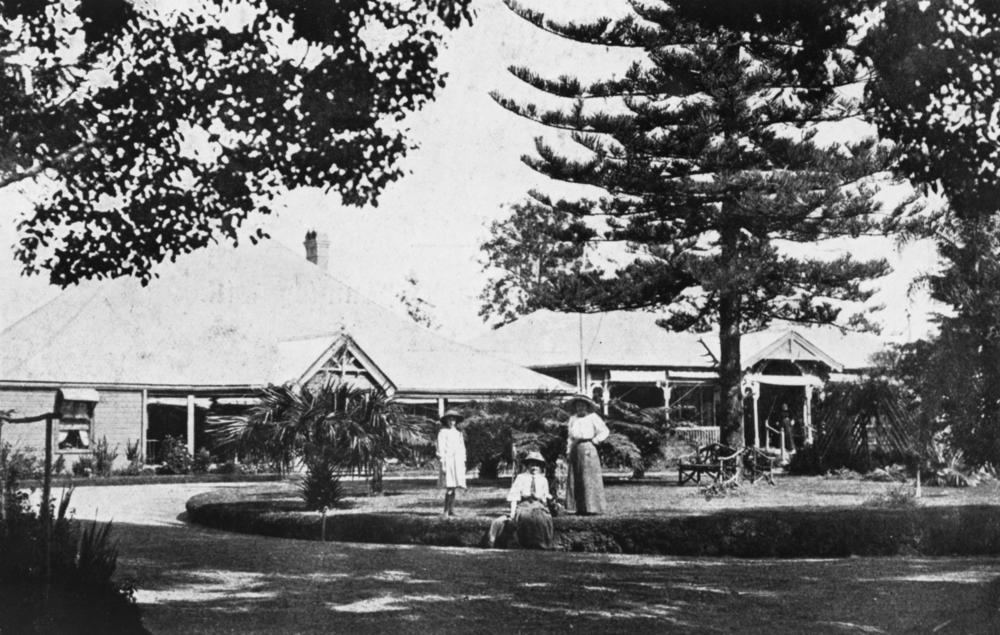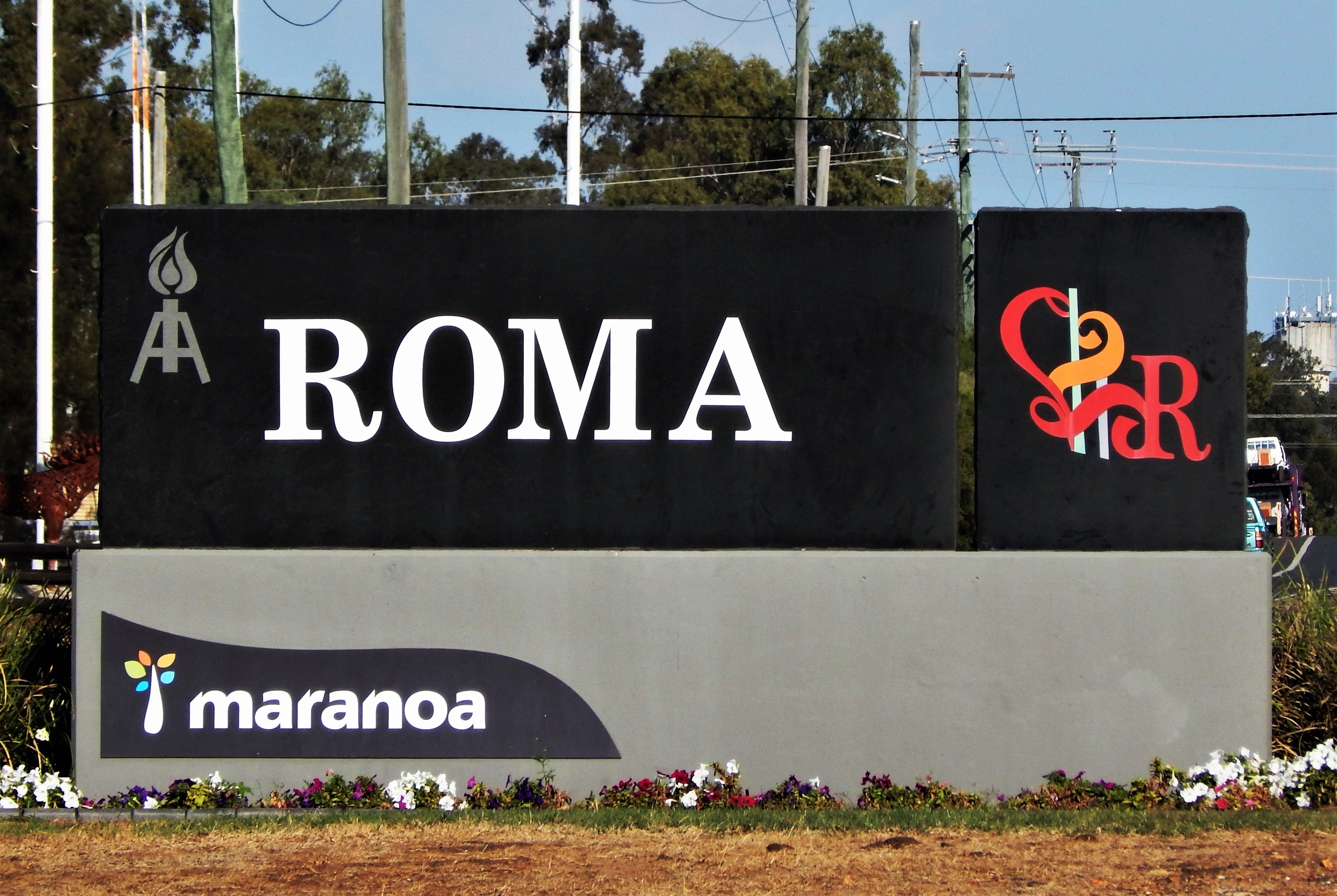|
Coominya Soldier Settlement
Coominya Soldier Settlement was a soldier settlement in Coominya in the present-day Somerset Region local government area of South East Queensland, Australia. 100 soldiers settled in the settlement, each on approximately blocks. Approximately 3,000 acres of land was purchased from Messrs Robert, Samuel and William Watson on both sides of the Brisbane Valley railway line (Portions 94 to 141, Parish of Buaraba, and Portions 126 to 151 and 107 to 125, Parish of Wivenhoe). Part of the cattle station Bellevue (Portion 152 to 166, Parish of Wivenhoe) was also purchased and the total surveyed into 109 blocks of between and opened for settlement on 1 June 1920. Based on existing successful farms in the district, soldier settlers were encouraged to grow grapes and citrus trees. Each soldier was granted favourable terms to purchase land and equipment up to the value of £625 ($1,250). This covered the purchase of the land, a four roomed house, a horse and cart, a 6” hand plough, a hand ... [...More Info...] [...Related Items...] OR: [Wikipedia] [Google] [Baidu] |
Soldier Settlement (Australia)
Soldier settlement was the settlement of land throughout parts of Australia by returning discharged soldiers under soldier settlement schemes administered by state governments after World War I and World War II. The post-World War II settlements were co-ordinated by the Commonwealth Soldier Settlement Commission. World War I Such settlement plans initially began during World War I, with South Australia first enacting legislation in 1915. Similar schemes gained impetus across Australia in February 1916 when a conference of representatives from the Australian Government and all the state governments was held in Melbourne to consider a report prepared by the Federal Parliamentary War Committee regarding the settlement of returned soldiers on the land. The report focused specifically on a federal-state cooperative process of selling or leasing Crown land to soldiers who had been demobilised following the end of their service in this first global conflict. The meeting agreed th ... [...More Info...] [...Related Items...] OR: [Wikipedia] [Google] [Baidu] |
Coominya, Queensland
Coominya is a rural town and locality in the Somerset Region in South East Queensland, Australia. The town is located west of the state capital, Brisbane and approximately from Wivenhoe Dam. In the , Coominya had a population of 1,200 people. Coominya sits on the land of the Indigenous Jagera people. Geography Coominya is bounded by Logan Creek to the north and Buaraba Creek to the south. Although located closely between Atkinson Dam to the south-west and Lake Wivenhoe to the north-east, it does not bound either of these two reservoirs. The Brisbane Valley Highway approximately follows its north-east border. The Brisbane Valley railway line passes through Coominya from the north-west to the south-east with the Coominya railway station serving the town. However, the railway line was closed in 1993. History From 1886 to 1906, the area was known as ''Bellevue'' (the local pastoral property). The name ''Coominya'' is believed to be derived from the Yuggera language where '' ... [...More Info...] [...Related Items...] OR: [Wikipedia] [Google] [Baidu] |
Somerset Region
The Somerset Region is a local government area located in the West Moreton region of South East Queensland, Australia, about northwest of Brisbane and centred on the town of Esk. It was created in 2008 from a merger of the Shire of Esk and the Shire of Kilcoy. It is commonly known as the Brisbane Valley, due to the Brisbane River which courses through the region, although significant parts of the region lie outside the hydrological Brisbane Valley itself. The Esk and Kilcoy Shires were amalgamated to consolidate the water catchments for the Wivenhoe and Somerset Dams. The Local Government Reform Commission identified that the long-term future of Somerset would be as a major water catchment for the SEQ region with farming being the main economic activity within a water catchment management regime. The "planning strategy and land use policies" implemented by the Somerset Regional Council are therefore "directed this end". The Somerset Regional Council, which administers the ... [...More Info...] [...Related Items...] OR: [Wikipedia] [Google] [Baidu] |
South East Queensland
South East Queensland (SEQ) is a bio-geographical, metropolitan, political and administrative region of the state of Queensland in Australia, with a population of approximately 3.8 million people out of the state's population of 5.1 million. The area covered by South East Queensland varies, depending on the definition of the region, though it tends to include Queensland's three largest cities: the capital city Brisbane; the Gold Coast; and the Sunshine Coast. Its most common use is for political purposes, and covers and incorporates 11 local government areas, extending from Noosa in the north to the Gold Coast and New South Wales border in the south (some sources include Tweed Heads, New South Wales which is contiguous as an urban area with Brisbane/Gold Coast), and west to Toowoomba (which is simultaneously considered part of the Darling Downs region). South East Queensland was the first part of Queensland to be settled and explored by Europeans. Settlements initially aro ... [...More Info...] [...Related Items...] OR: [Wikipedia] [Google] [Baidu] |
Mackay Daily Mercury
The ''Daily Mercury'' is an online newspaper which serves the Mackay region in Queensland, Australia. Print edition was later revived with a publication on Friday only. The newspaper is printed by Mackay Printing and Publishing and is owned by News Corp Australia. History The Daily Mercury ran from 1866 to 1905 as the ''Mackay Mercury and South Kennedy Advertiser''. From 1887 the paper was issued under the name ''Mackay Mercury'' until 1906 when the ''Daily Chronicle'' was absorbed by the paper and it was renamed the ''Daily Mercury''. Along with many other regional Australian newspapers owned by NewsCorp, the Daily Mercury ceased print editions in June 2020 and became online-only publication. The print edition was revived in late August, 2021 as a weekly, Friday-only edition. Editors * ?? - May 2011: David Fisher * May 2011 - ??: Jennifer Pomfrett * ?? - ??: Jennifer Spilsbury * ?? - ??: Jon Ortlieb * November 2014 - ?? : Meredith Papavasiliou * ?? - June 2018: Ro ... [...More Info...] [...Related Items...] OR: [Wikipedia] [Google] [Baidu] |
Brisbane Valley Railway Line
The Brisbane Valley railway line was a railway connection in Queensland, Australia connecting Ipswich, west of Brisbane, to the upper Brisbane River valley. Progressively opened between 1884 and 1913, the railway provided a vital transport link between Ipswich and Yarraman and forged development and prosperity along its path. The line acquired its serpentine reputation because it did not take a straight course when faced with a hill or gully."Triumph of Narrow Gauge: A History of Queensland Railways" by John Kerr 1990 Boolarong Press, Brisbane The line branched from the main western line to Toowoomba at Wulkuraka a short distance west of Ipswich and struck a north-westerly route towards Fernvale and Lowood before continuing on via Toogoolawah and Blackbutt to Yarraman. It became one of the few branch lines to accommodate passenger and mixed trains and the introduction in 1928 of rail motor services ensured that it retained an important passenger traffic role. Passenger s ... [...More Info...] [...Related Items...] OR: [Wikipedia] [Google] [Baidu] |
Bellevue Homestead
Bellevue Homestead is a heritage-listed homestead currently located in Coominya, Somerset Region, Queensland, Australia. It was built from to . It was added to the Queensland Heritage Register on 21 October 1992. The Bellevue property was the western part of the original Wivenhoe Run established in the 1840s which covered on the western side of the Brisbane River valley. A large portion of this land is now part of the Wivenhoe Dam. The homestead was restored by the National Trust of Queensland between 1975 and 1980 after moving the buildings from the banks of the Brisbane River to the nearby town of Coominya to avoid being flooded. History 19th century In 1848, John Stephen Ferriter and Edmund Blucher Uhr squatted on close to limits of convict colony of Moreton Bay and called it Wivenhoe Run after the town in England. They grazed sheep and built two single roomed huts. The eastern hut was called Wivenhoe Homestead and the western slab hut was called Bellevue Homestead. The ... [...More Info...] [...Related Items...] OR: [Wikipedia] [Google] [Baidu] |
Redcliffe, Queensland
Redcliffe is a town and suburb in the Moreton Bay Region, Queensland, Australia. It also refers colloquially to the Redcliffe Peninsula as a whole, a peninsula jutting into Moreton Bay which contains several other suburbs. Since the 1880s, Redcliffe has been a popular seaside resort in South East Queensland. In the , the suburb of Redcliffe had a population of 10,373 people. Geography Redcliffe is situated in the east north-east of the Redcliffe Peninsula on the western shore of the Moreton Bay. It is approximately north-north-east of the Brisbane CBD. It serves as the Central Business District for the Redcliffe Peninsula and its surrounding suburbs. History Before European settlement, the Redcliffe Peninsula was occupied by the Ningy Ningy people. The Aboriginal name is ''Kau-in-Kau-in'', which means Blood-Blood (red-like blood). A famous Ningy Ningy Bora ring structure, consisting of two separate rings, large and small, joined by a ritual pathway, once existed betwe ... [...More Info...] [...Related Items...] OR: [Wikipedia] [Google] [Baidu] |
Kingaroy, Queensland
Kingaroy is a rural town and suburbs and localities (Australia), locality in the South Burnett Region, Queensland, Australia. The town is situated on the Road Junction, junction of the D'Aguilar Highway, D'Aguilar and the Bunya Highway, Bunya Highways, north-west of the state capital Brisbane and south west of Gympie. As at June 2018, Kingaroy had a population of 10,398. Estimated resident population, 30 June 2018. It is known as the "Peanut Capital of Australia" because Australia's largest peanut processing plant is located in the town and it's peanut silo dominates the skyline. Kingaroy is also known as the hometown of former Premier of Queensland, Joh Bjelke-Petersen, Sir Joh Bjelke-Petersen. Geography Kingaroy is surrounded by extensive (and very picturesque) farmlands interspersed with low rolling hills. The Booie Range lies immediately north-east of the town and the Bunya Mountains about to the south-west. The Stuart River (Queensland), Stuart River () flows northwa ... [...More Info...] [...Related Items...] OR: [Wikipedia] [Google] [Baidu] |
Ridgelands, Queensland
Ridgelands is a rural locality in the Rockhampton Region, Queensland, Australia. In the Ridgelands had a population of 166 people. History Ridgelands Provisional School opened on 12 October 1921. On 1 July 1924 it became Ridgelands State School. On 26 August 1924 it was renamed Calmorin State School. In 1925 it closed, but reopened on 29 January 1935. It closed on 31 December 1963. Faraday State School began in temporary accommodation at Ridgelands Hall on 28 July 1922 but opened in its own building on 2 September 1922. It closed in 1928 but reopened in 1931 and closed again in 1932. In 1939 it reopened but was relocated and renamed Ridgelands State School. In the Ridgelands had a population of 166 people. Education Ridgelands State School is a government primary (Prep-6) school for boys and girls at 43 Dalma-Ridgelands Road (). In 2018, the school had an enrolment of 33 students with 4 teachers (3 full-time equivalent) and 6 non-teaching staff (3 full-time equivalent). ... [...More Info...] [...Related Items...] OR: [Wikipedia] [Google] [Baidu] |
Roma, Queensland
Roma is a rural town and locality in the Maranoa Region, Queensland, Australia. It is the administrative centre of the Maranoa Region. The town was incorporated in 1867 and is named after Lady Diamantina Bowen (née di Roma), the wife of Sir George Bowen, the Governor of Queensland at the time. In the , the locality of Roma had a population of 6,848 people. Geography Roma is in the Maranoa district of South West Queensland, Australia, situated * by rail and road WNW of Brisbane * 355 km (221 mi) W of Toowoomba, * 269 km (167 mi) W of Dalby * 141 km (87.6 mi) W of Miles * 87 km (54 mi) E of Mitchell * 176.6 km (109.7 mi) E of Morven * 266 km (165 mi) E of Charleville It is situated at the junction of the Warrego and Carnarvon highways. It is the centre of a rich pastoral and wheat-growing district. It is also a major town on the Western Railway Line from Toowoomba and Brisbane. History Prior the European settlement the Aboriginal peoples of the Mandandanji Nation o ... [...More Info...] [...Related Items...] OR: [Wikipedia] [Google] [Baidu] |
Nanango, Queensland
Nanango is a rural town and locality in the South Burnett Region, Queensland, Australia. In the , the locality of Nanango had a population of 3,599 people. Geography Nanango is situated north-west of the state capital, Brisbane, at the junction of the D'Aguilar Highway with the Burnett Highway. Sandy Creek () meanders through the town. The locality is part of the Burnett River catchment. The productive lands of the catchment feature sedimentary floodplains. The rich fertile soils of the floodplains are the agricultural and resource backbone of the region. While there are benefits of the flooding there are also risks including the loss of vegetation in riparian zones, biosecurity issues and spread of weed species. History The original inhabitants of the area were the Aboriginal people belonging to the Wakka Wakka (or Waka Waka) people. The area was used as a gateway to the bunya nut festivals, where Aboriginal people would travel from as far away as the Clarence River i ... [...More Info...] [...Related Items...] OR: [Wikipedia] [Google] [Baidu] |








